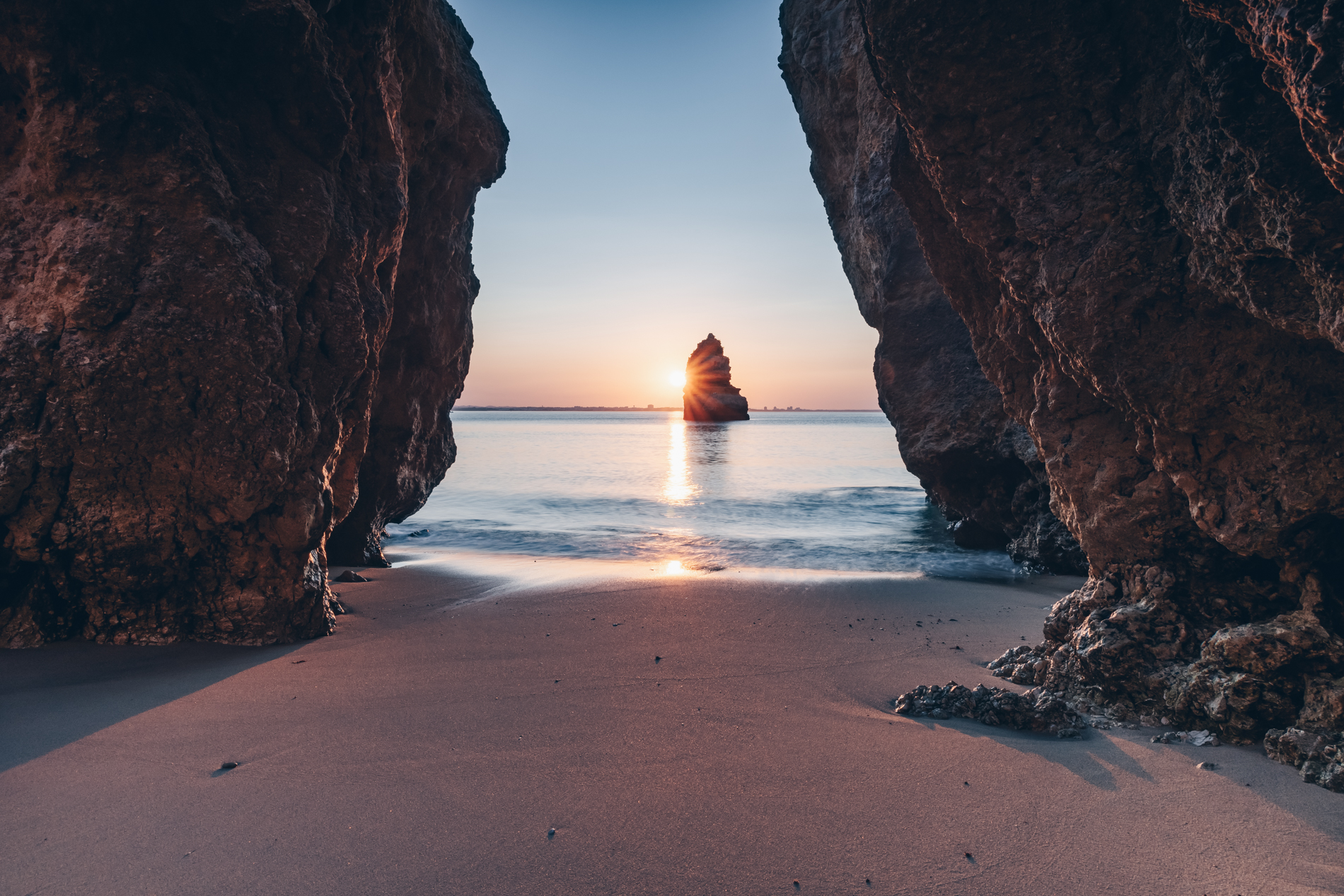Golden sandy beaches, red rocky cliffs, secluded bays and bright blue water sound like paradise to you? If so, the beaches in the Algarve in southern Portugal are your next dream destination!
With around 300 days of sunshine a year, dry summers and mild winters, Portugal’s southern Atlantic coast is a true year-round destination, yet it’s never overcrowded. With around 100 official beaches to choose from, with more than 96 miles of coastline, the Algarve is a mecca for sun worshipers. The small bays with rugged cliffs in the west (from Cabo de São Vicente to Faro) attract adventure seekers and surfers. Those looking for relaxation are drawn to the gently sloping beaches, dunes and sheltered lagoons of the Sandalgarve east of the lush port city of Faro.
The history of the Algarve is as varied as its appearance and even today the influence of the Romans and Moors are omnipresent. Bask in the beauty of the Roman ruins dotting Faro and Estói. Moorish history is reflected in colorful mosaics, intricately decorated azulejos, and the numerous citrus and almond trees. Even the name Algarve comes from the Arabic word al-gharb (the west).
The cuisine of the coastal region is determined by the sea: Fish, lobster, mussels and squid. Try amêijoas na cataplana with clams, a dish prepared in the eponymous cataplana pot. Or how about a caldeirada, a stew of fish, seafood, potatoes and vegetables? The perfect snack for small appetites is the cod pie pastéis de bacalhau.
With all the treats, the sheer endless choice of activities comes in handy. In addition to the classics—swimming, snorkeling or hiking—you can go surfing, stand-up paddling, kayaking and wine tasting. For more action, go on quad tours, jet skiing or parasailing. And last but not least, the Algarve is an increasingly popular destination for golfers—with courses that outdo each other in spectacular views of the sea and hinterland.
Luckily, you don’t have to decide where to go right away, as the region is well connected, so you can easily explore several charming towns and the best beaches in the Algarve by bus.
Ria Formosa Natural Park and Ilha da Culatra near Faro
The Ria Formosa Nature Reserve is one of the largest lagoon landscapes in Europe, covering around 66 square miles. The labyrinth of islands, channels, marshes and sandbanks is one of Portugal’s seven natural wonders and can only be reached by a short ferry crossing from Faro or Olhão.
Start at the Quinta de Marim Visitor Center near Olhão on the mainland, which gives you a glimpse about this special nature reserve within a small space. On the two-miles-long trail, you’ll explore salt ponds, pine forests and dune landscapes. Along the way, you’ll encounter numerous birds, a tide mill dating back to 1845, and learn about the region’s fishing industry and the nearly extinct Portuguese water dog “Cão de Água” (remember Obama’s dog Bo?).
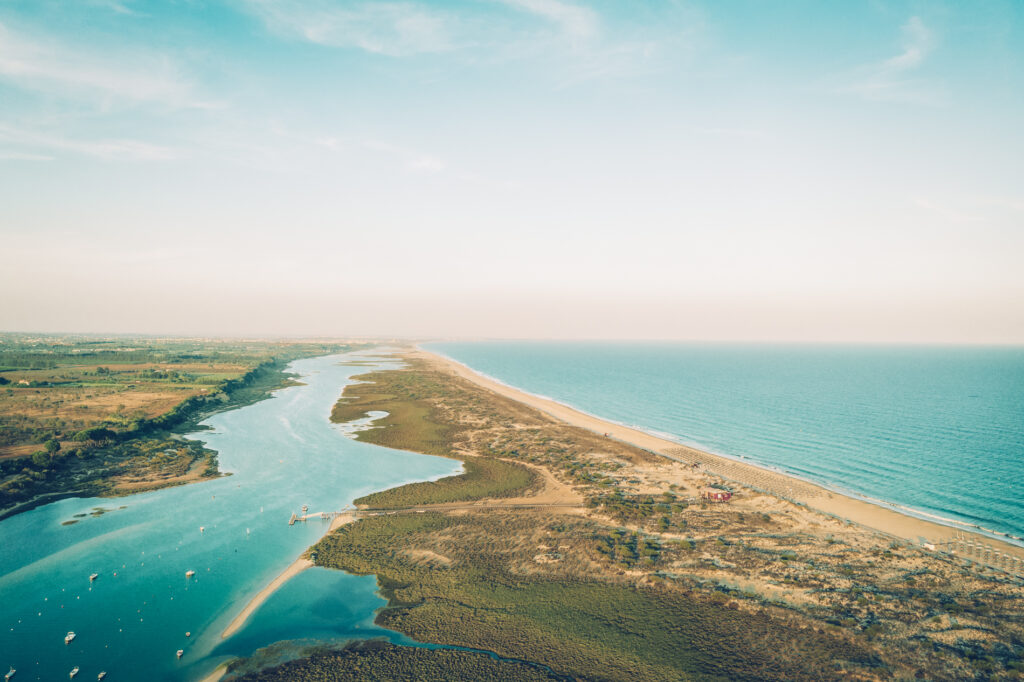
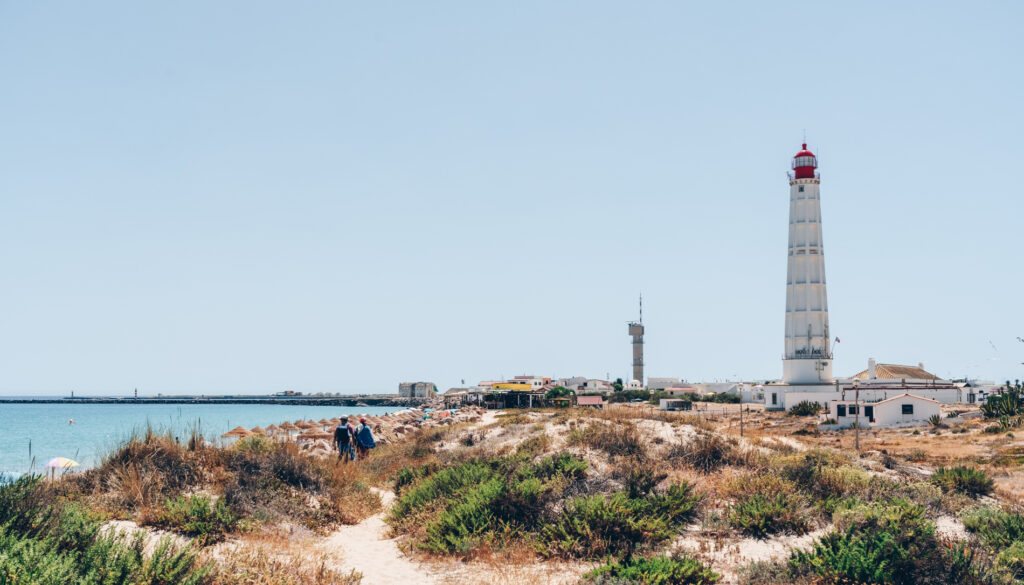
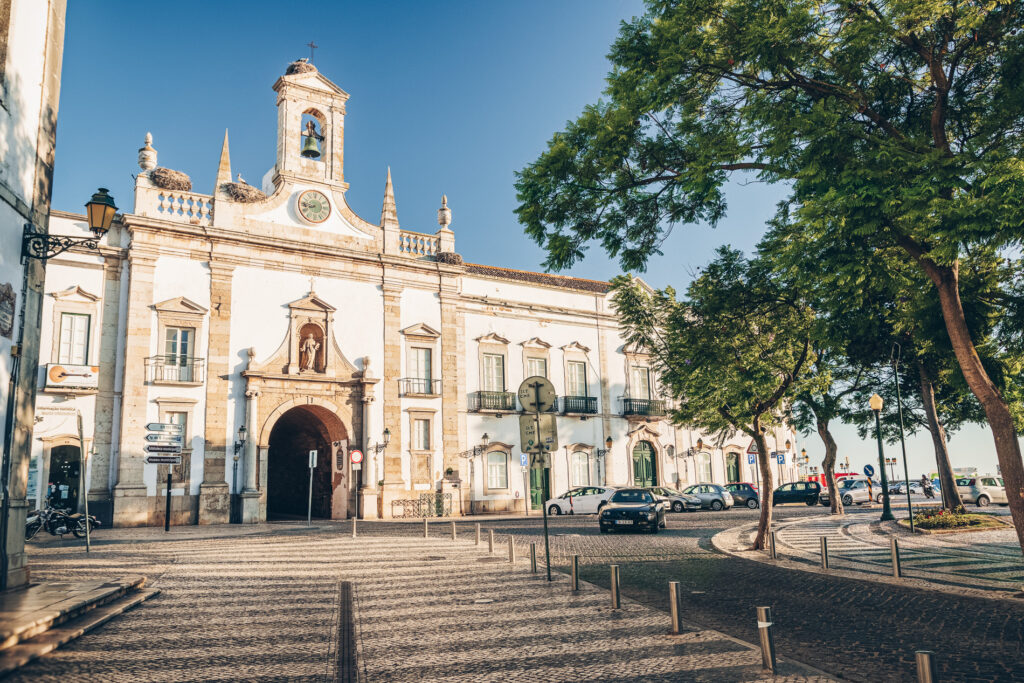
Perfectly attuned to the spectacular scenery, take the ferry to Ilha da Culatra, the “forgotten island”. Here, a four-miles-long nearly empty beach with powdery sand and crystal clear water awaits, since these islands are an insider tip. Just 1,000 people live on the car-free dune island.
Go snorkeling to find yourself among hundreds of seahorses or explore the nearby mussel beds at low tide. Walk to Farol, one of the three settlements, and you’ll meet local fishermen, herons, cormorants, and maybe even a few flamingos, while the white lighthouse with a red top guides your way. After 220 sweaty steps to the lighthouse’s observation deck, a breathtaking panoramic view of the nature reserve awaits before you reward yourself back on solid ground at the À-do-João restaurant with a portion of freshly caught oysters and a glass of Vinho Verde.
Since there are no hotels on the island and the number of private accommodations is modest, nearby Faro is a good option. Stroll along the Moorish city walls and enter the old town (Cidade Velha) through the Arco da Vila, one of the medieval city gates. Wander through the picturesque streets and visit the Sé, Faro’s unpretentious cathedral with its splendidly decorated interior, and the magnificent baroque church of Igreja do Carmo. Here you’ll find the Capela dos Ossos, the bone chapel built in 1816—eerie and fascinating at the same time.
Praia da Ilha de Tavira near Tavira
At the eastern end of the Ria Formosa Nature Reserve lies another jewel with miles of secluded beaches: Ilha de Tavira.
Bright, fine sand and crystal clear water stretch as far as the eye can see across the seven-mile-long island. In the east, you’ll find Praia da Ilha de Tavira, which runs flat into the sea and has all kinds of amenities. Rent a sun lounger and grab a tasty cocktail from one of the bars to relax to the sound of the sea. For a little action, take a windsurfing course. In summer, enjoy an estupeta, a fresh salad with tuna, in one of the nearby restaurants. In general you should try a dish with tuna (atum), as Tavira is heavily influenced by it. A whimsical monument on Praia do Barril is a memorial to this. Here, anchors lie in the dunes as a silent tribute to the former heyday of tuna fishing. By the way, you don’t have to leave the island in the evening, but can extend your beach adventure at the local campsite for as long as you like.
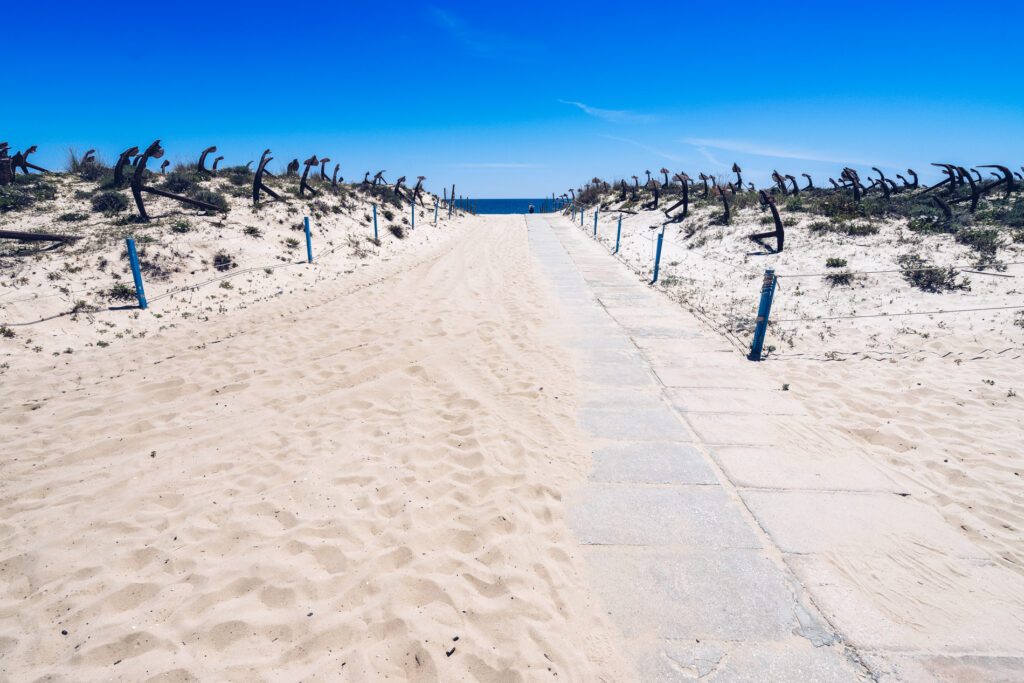
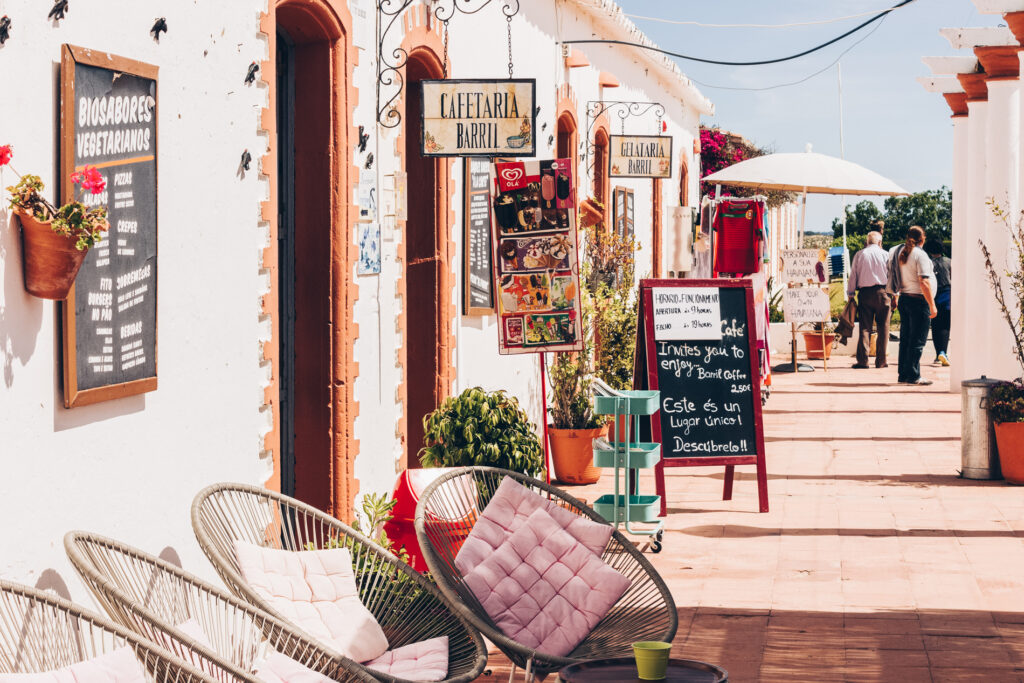
Take the ferry to Tavira, one mile away, for a little change of pace. Just outside the gates of this elegant town, surrounded by fragrant orchards and gentle hills, you’ll discover the pink and white fields where sea salt is produced. Admire the hustle and bustle of Praça da República, the center of town, over a morgado de figo (fig cake) or juicy toucinho do céu (almond cake), and pay a visit to Castelo de Tavira, an 11th-century ruin with a gorgeous garden. From the castle wall, you’ll have a fabulous panoramic view of the picturesque town and the Ponte Romana, one of Portugal’s oldest bridges, which spans the Rio Gilão with seven arches. On the way, visit the Igreja de Misericórdia as its wall decoration of ornate azulejos will take your breath away.

Praia de Benagil with Benagil cave near Albufeira
If there’s a signature photo of the Algarve, it’s one of the Benagil Cave, the most famous in Portugal. Hidden in the rugged cliffs the cave is affectionately known as the Cathedral. The sun shines in through a hole in the ceiling, bathing the grotto in pink-orange to golden light, while the approaching waves create a gentle echo.

This jewel of sandstone is best reached by water. Start at the nearby Praia de Benagil, the small sandy beach in the fishing village of Benagil, located about 15 miles from Albufeira. At low tide, rent a boat, kayak or SUP and make your way about 330 feet along the coast to the cave.
Another way to reach the grotto is to take a hike of about two hours from Praia Marinha along the cliffs, which affords spectacular views over the coastline, as well as the opportunity to view the Benagil cave from above through the ceiling.

Praia da Marinha beach, about a half-mile long and protected by 100 feet high cliffs, is also very popular with vacationers. With a little luck, you may even spot seahorses while snorkeling close to the whimsical rock formation reminiscent of an M washed by waves.
From Praia de Benagil, in the opposite direction, you’ll find Praia do Carvalho, which attracts adventure seekers in particular. Here, cliff jumpers plunge into the waters from a height of 33 feet, while spectators hold their breath.
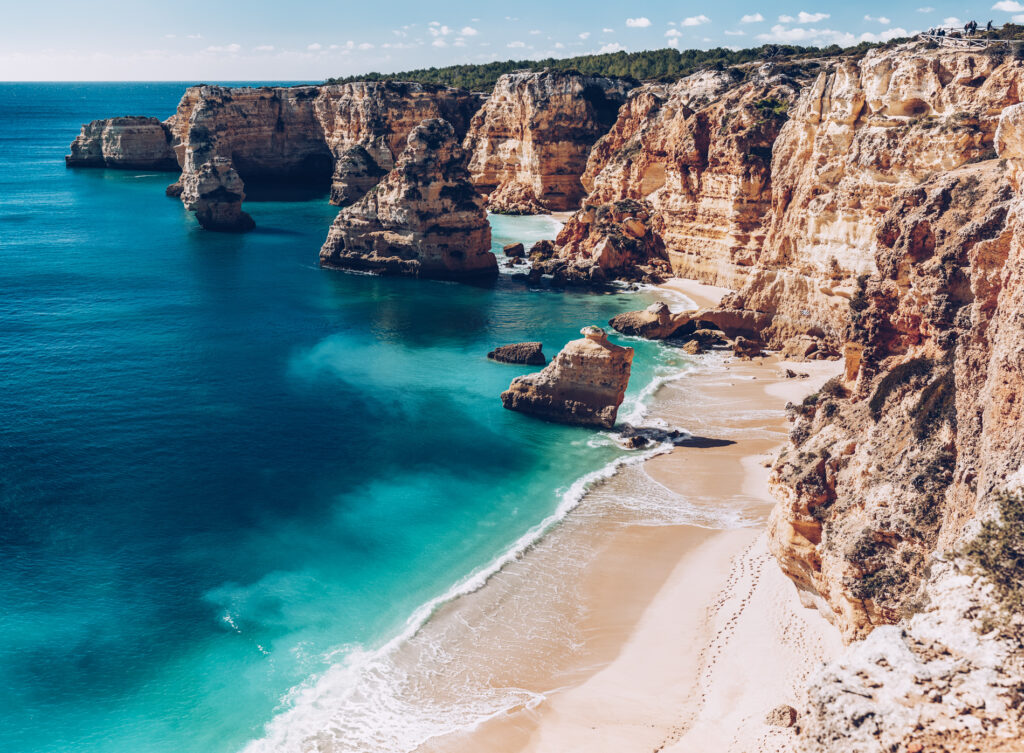
After an eventful day at the beach, vibrant Albufeira invites you to explore. Wander the narrow streets between the whitewashed houses and enjoy a delicious dinner in one of the more than 100 restaurants in the old town before diving into the legendary nightlife on the Strip.
Ponta da Piedade and Praia do Camilo near Lagos
On a headland two miles south of Lagos lies one of Portugal’s most impressive rock formations: the Ponta da Piedade. Over thousands of years, wind and waves shaped the golden, bizarre limestone cliffs and stone columns. Some of them resemble animals—like the Elefante.

Start at the port of Lagos by taking the slow train to the viewpoint at the high cliffs of Ponta da Piedade. To take full advantage of the view, make your way to the top of the lighthouse. From here, you can see across Lagos Bay to the east, as far as the Serra de Monchique mountain range to the north, and as far as Sagres to the west. Back on the ground, take the nearby stone steps (left from the lighthouse, behind the souvenir stores) to get to the small sandy beach for a short cool down. Now, either continue to follow the wooden stairs to the hidden grottos, tunnels and arches or explore them by boat or kayak at low tide.
If the small bathing bay is too crowded, there are several alternatives in the immediate vicinity. Follow the path by the lighthouse for about a half mile past Praia da Balança and Praia dos Pinheiros and you’ll see the wooden steps leading down to Praia do Camilo. The beach consists of two small coves connected by a tunnel, and with its golden fine sand and shallow turquoise waters, it’s one of the most stunning in the entire Algarve. For the perfect view and a romantic sunset dinner, just go back up the steps and treat yourself to fresh seafood and a pudim de laranja (orange pudding) at O Camilo restaurant.

Nearby Lagos promises the perfect mix of lively nightlife and historical highlights. Lose yourself in the picturesque streets of the old town, which has retained its original charm with authentic restaurants, whitewashed houses and baroque churches. Afterwards, end the evening with a drink in the apart illuminated harbor.
Praia do Martinhal and Cabo de São Vicente near Sagres
At the southwestern end of the Algarve, where the wind gets stronger and the waves get higher, lies the small, sleepy town of Sagres with four beaches within walking distance.

To the east is the popular half-mile-long Praia do Martinhal beach, which is accessible via a wooden path even for travelers with limited mobility. Protected from the wind by Baleeira Bay, the water is calm and the gently sloping beach invites you to swim and linger. Small charming cafes and a sun lounger rental service make the visit all the more enjoyable. But don’t be fooled: Further out on the water, the wind freshens noticeably and offers perfect conditions for kite- and windsurfers. Book the right equipment or a taster course directly on the beach. With good weather conditions, you can see the small limestone islands Ilhotes do Martinhal, which attract numerous divers thanks to the clear view and the rich underwater world.
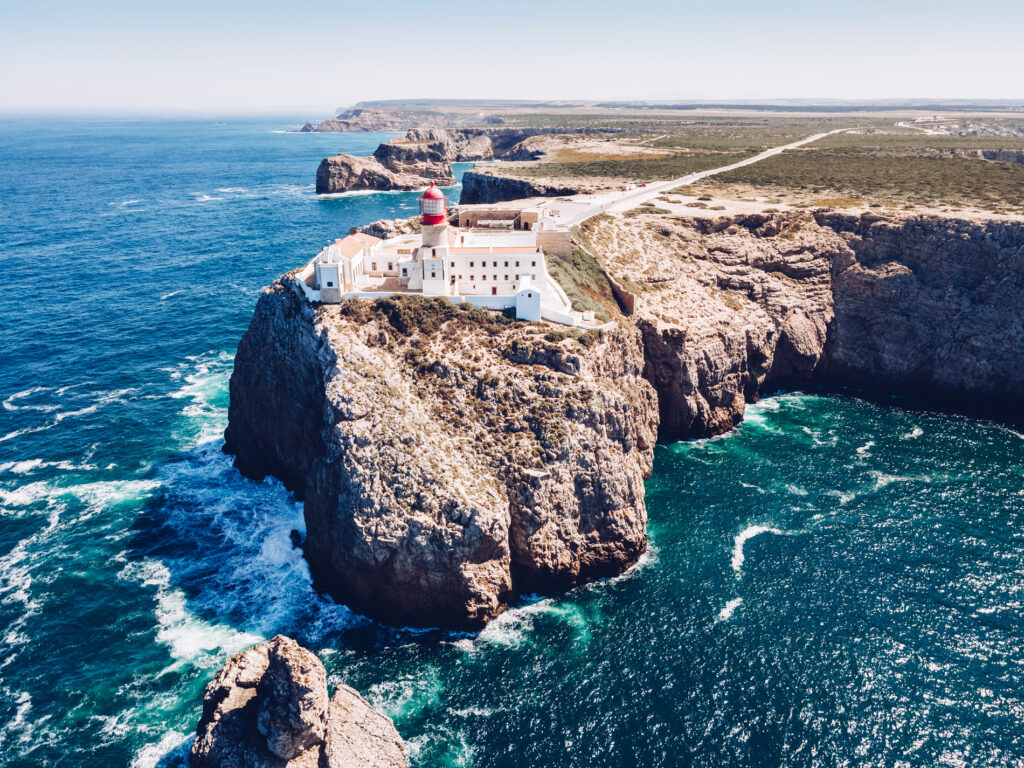
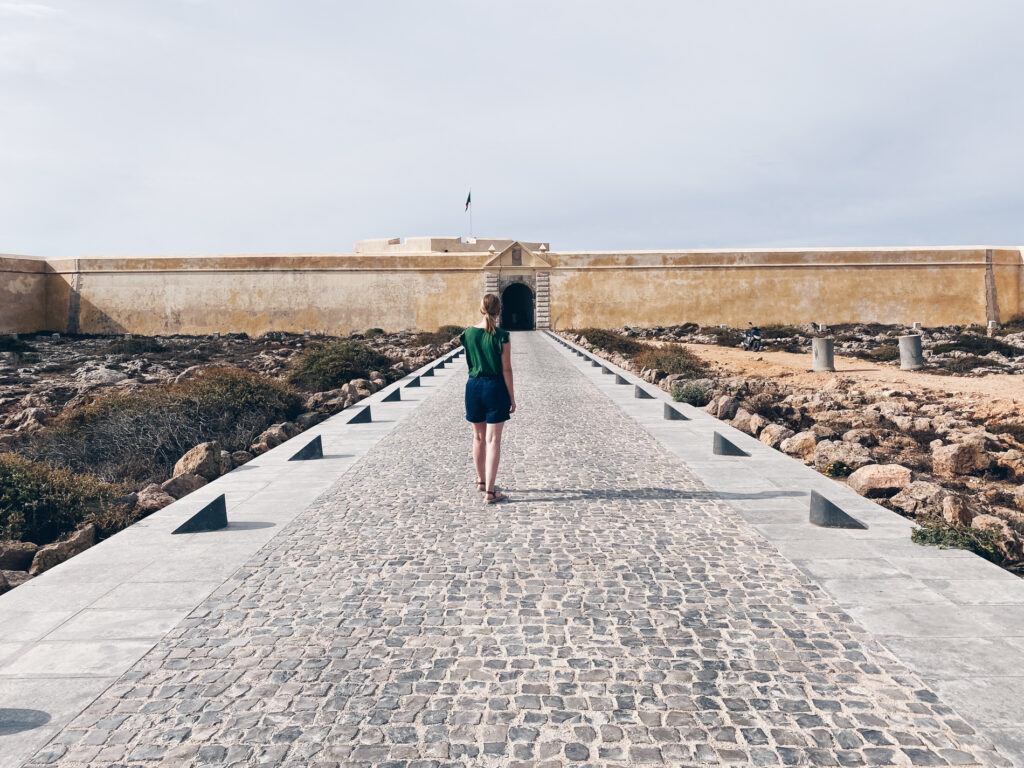

Surfers are drawn to Praia da Mareta, another of Sagres’ beaches, located further south. Beginners to professionals venture into the dark blue waves breaking left or right, reaching between three and ten feet.
To the south off Sagres coast are the ruins of the fortress, the Fortaleza de Sagres, and a stone circle whose origin is still unclear. It’s believed that the circle, about 140 feet in diameter, once served as a sundial or wind rose (Rosa dos Ventos).
Rent a mountain bike and explore Cabo de São Vicente, about four miles from Sagres, the southwesternmost point of mainland Europe, which is the subject of various legends. In Roman times, the place was called Promontorium sacrum (Sacred Promontory). The Romans believed that the gods lived here and that the sun sank into the sea. Even today, numerous people gather every evening to watch the red glowing sun set into the Atlantic Ocean. The perfect end to an eventful day!
